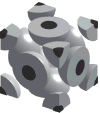Sensitivity of MR diffusion measurements to variations in intracellular structure: effects of nuclear size
- PMID: 19205020
- PMCID: PMC2749035
- DOI: 10.1002/mrm.21793
Sensitivity of MR diffusion measurements to variations in intracellular structure: effects of nuclear size
Abstract
Magnetic resonance imaging measurements of the apparent rate of water diffusion in tumors are sensitive to variations in tissue cellularity, which have been shown useful for characterizing tumors and their responses to treatments. However, because of technical limitations on most MRI systems, conventional pulse gradient spin echo (PGSE) methods measure relatively long time scales, during which water molecules may encounter diffusion barriers at multiple spatial scales, including those much greater than typical cell dimensions. As such they cannot distinguish changes on subcellular scales from gross changes in cell density. Oscillating gradient spin echo (OGSE) methods have the potential to distinguish effects on restriction at much shorter time and length scales. Both PGSE and OGSE methods have been studied numerically by simulating diffusion in a three-dimensional, multicompartment tissue model. The results show that conventional measurements with the PGSE method cannot selectively probe variations over short length scales and, therefore, are relatively insensitive to intracellular structure, whereas results using OGSE methods at moderate gradient frequencies are affected by variations in cell nuclear sizes and can distinguish tissues that differ only over subcellular length scales. This additional sensitivity suggests that OGSE imaging may have significant advantages over conventional PGSE methods for characterizing tumors.
Figures




Similar articles
-
Dependence of temporal diffusion spectra on microstructural properties of biological tissues.Magn Reson Imaging. 2011 Apr;29(3):380-90. doi: 10.1016/j.mri.2010.10.002. Epub 2010 Dec 3. Magn Reson Imaging. 2011. PMID: 21129880 Free PMC article.
-
Characterizing tumor response to chemotherapy at various length scales using temporal diffusion spectroscopy.PLoS One. 2012;7(7):e41714. doi: 10.1371/journal.pone.0041714. Epub 2012 Jul 24. PLoS One. 2012. PMID: 22911846 Free PMC article.
-
Probing neural tissues at small scales: Recent progress of oscillating gradient spin echo (OGSE) neuroimaging in humans.J Neurosci Methods. 2021 Feb 1;349:109024. doi: 10.1016/j.jneumeth.2020.109024. Epub 2020 Dec 14. J Neurosci Methods. 2021. PMID: 33333089 Free PMC article.
-
Measuring restriction sizes using diffusion weighted magnetic resonance imaging: a review.Magn Reson Insights. 2013 May 19;6:59-64. doi: 10.4137/MRI.S11149. eCollection 2013. Magn Reson Insights. 2013. PMID: 25114548 Free PMC article. Review.
-
Characterization of tissue structure at varying length scales using temporal diffusion spectroscopy.NMR Biomed. 2010 Aug;23(7):745-56. doi: 10.1002/nbm.1531. NMR Biomed. 2010. PMID: 20677208 Free PMC article. Review.
Cited by
-
Dependence of temporal diffusion spectra on microstructural properties of biological tissues.Magn Reson Imaging. 2011 Apr;29(3):380-90. doi: 10.1016/j.mri.2010.10.002. Epub 2010 Dec 3. Magn Reson Imaging. 2011. PMID: 21129880 Free PMC article.
-
Noninvasive assessment of liver inflammation in metabolic dysfunction associated steatohepatitis using MR cytometry.Npj Imaging. 2025 May 3;3(1):17. doi: 10.1038/s44303-025-00080-4. Npj Imaging. 2025. PMID: 40603546 Free PMC article.
-
Time-dependent diffusion in undulating thin fibers: Impact on axon diameter estimation.NMR Biomed. 2020 Mar;33(3):e4187. doi: 10.1002/nbm.4187. Epub 2019 Dec 23. NMR Biomed. 2020. PMID: 31868995 Free PMC article.
-
Proving of a Mathematical Model of Cell Calculation Based on Apparent Diffusion Coefficient.Transl Oncol. 2017 Oct;10(5):828-830. doi: 10.1016/j.tranon.2017.08.001. Epub 2017 Aug 29. Transl Oncol. 2017. PMID: 28863287 Free PMC article.
-
A comparative assessment of preclinical chemotherapeutic response of tumors using quantitative non-Gaussian diffusion MRI.Magn Reson Imaging. 2017 Apr;37:195-202. doi: 10.1016/j.mri.2016.12.002. Epub 2016 Dec 3. Magn Reson Imaging. 2017. PMID: 27919785 Free PMC article.
References
-
- Cory DG, Garroway AN. Measurement of translational displacement probabilities by NMR: an indicator of compartmentation. Magn Reson Med. 1990;14(3):435–444. - PubMed
-
- Assaf Y, Mayk A, Cohen Y. Displacement imaging of spinal cord using q-space diffusion-weighted MRI. Magn Reson Med. 2000;44(5):713–722. - PubMed
-
- Chin CL, Wehrli FW, Fan Y, Hwang SN, Schwartz ED, Nissanov J, Hackney DB. Assessment of axonal fiber tract architecture in excised rat spinal cord by localized NMR q-space imaging: simulations and experimental studies. Magn Reson Med. 2004;52(4):733–740. - PubMed
-
- Moseley ME, Cohen Y, Mintorovitch J, Chileuitt L, Shimizu H, Kucharczyk J, Wendland MF, Weinstein PR. Early detection of regional cerebral ischemia in cats: comparison of diffusion- and T2-weighted MRI and spectroscopy. Magn Reson Med. 1990;14(2):330–346. - PubMed
Publication types
MeSH terms
Grants and funding
LinkOut - more resources
Full Text Sources
Other Literature Sources
Research Materials

